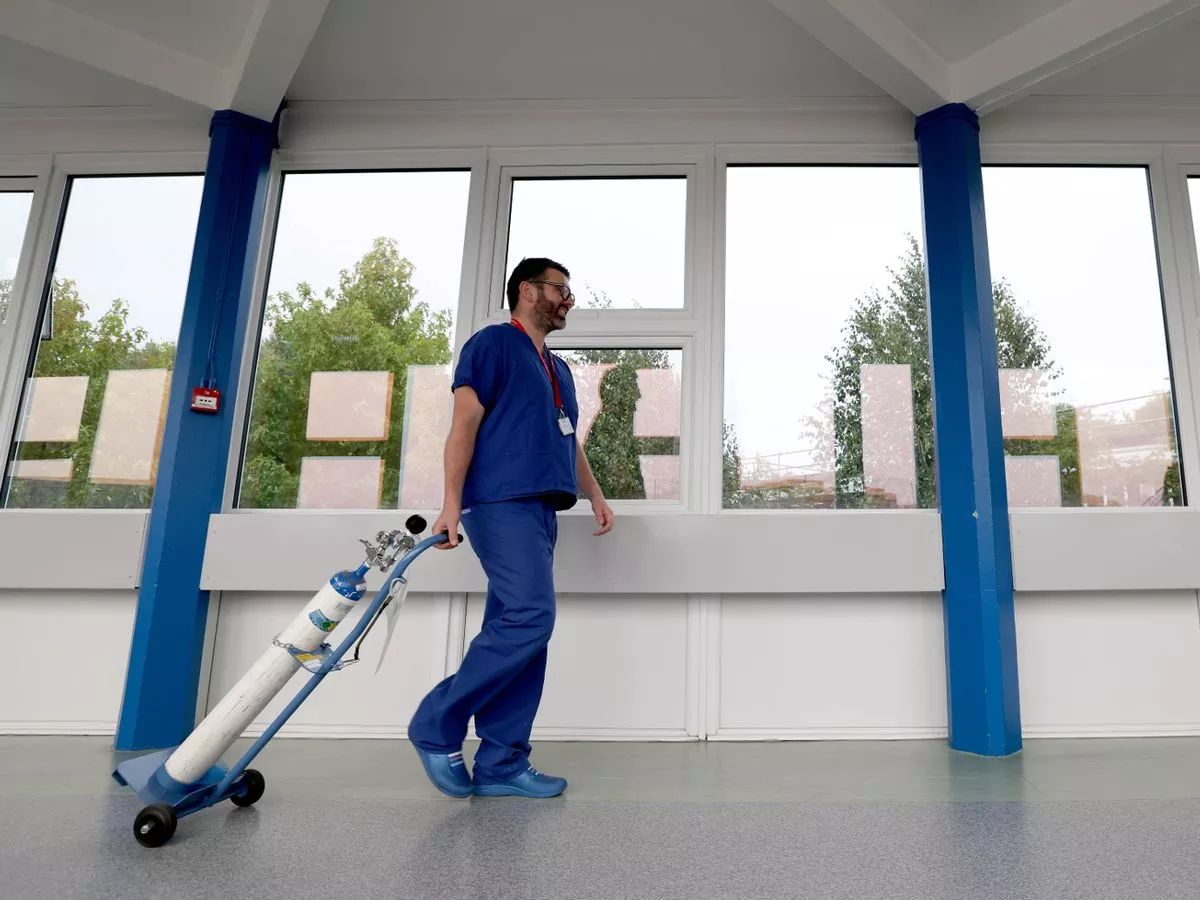By Helena Vesty
Copyright manchestereveningnews

“It’s a bit like having beer on draft versus a bottle bar,” says Cliff Shelton. “We were treating our supply like it was a massive keg of Fosters that everybody wanted to have a pint of. Except that everyone hates Fosters and it never got sold.” Cliff, a consultant anaesthetist, isn’t actually talking about your favourite local though. Or whether Foster is, in fact, a good call. Take a trip through many hospitals around the world and you’ll find the same thing in plenty of them. Hospital gas pipelines that have been part of the fixtures for decades, snaking their way through the corridors to wards and operating theatres. They’ve long been filled with nitrous oxide – perhaps known to many of us as ‘laughing gas’ – to be used as anaesthetic, as it has for more than 150 years. Get news, views and analysis of the biggest stories with the daily Mancunian Way newsletter – sign up here Nitrous oxide is also infamous for another reason. It comes out of the millions of cars on the road, and the thousands of flights taking to the sky every day. It’s a greenhouse gas nearly 300 times more potent than carbon dioxide. Manchester is home to the biggest group of hospitals in the country. Manchester University NHS Foundation Trust (MFT) trust boasts 10 major hospitals across a range of specialities, including the Manchester Royal Infirmary, North Manchester General, and the Royal Manchester Children’s. But that also means the city’s hospital trust became the country’s biggest NHS emitter of nitrous oxide. And while the gas flowed throughout our hospitals, most of the supply was leaking out into the atmosphere as it easily escaped through the pipelines, the rest of it was not even being used – and all of it was having a massive impact on the environment. “Nitrous oxide had a use prior to the 1990s which was really sensible and practical because it helped anaesthetic medications to work faster and wear off quicker,” Dr Shelton told the Manchester Evening News . “But once we brought in faster acting drugs, which have now been around for 20 or 30 years, the rationale for using nitrous oxide in anaesthesia started to fade . “In practice, we tended to stop using it. One of the reasons for that, very simply, is it makes patients sick. It’s not actually a brilliant drug if you don’t need to use it. “We mostly swapped over to using drugs that go into patients’ veins, rather than drugs that go in on an inhaled-basis. “They’re even better still in terms of avoiding sickness and giving you a clear head after your operation.” There was a catch, though. “Practitioners like anaesthetists can do whatever they want, but unless they tell the hospital that they’ve stopped using this thing, the hospital might just continue to supply it like it always did,” explains Dr Shelton, sitting in Wythenshawe Hospital where he works. “When we had our nitrous oxide system piped centrally in this hospital, we were having all the cylinders attached to that system replaced twice a week. That meant that a big lorry came along and swapped all of those over. “And 99 per cent of the gas wasn’t even being used.” The most up-to-date verified figures from the Department for Environment Food and Rural Affairs’ (DEFRA) air quality compliance hub, from 2023, show that Manchester has the worst air pollution levels in the country. And the need to do something about pollution in the city is desperate , say parents. Figures obtained by campaign group, Mums for Lungs, under the Freedom of Information Act earlier this year, show that in the last two years nearly 8,500 children were admitted to the specialist paediatric respiratory services at Manchester hospitals, or seen as outpatients. The number of under-18s attending hospitals has gone up by 520 in only 12 months, the figures show. Babies and toddlers are particularly affected. Young children aged three or under admitted to hospital or attending outpatient services for specialist respiratory medicine have jumped by 33 per cent from 654 to 872. One simple change, thanks to eagle-eyed staff, has made a colossal impact on pollution by the city’s NHS. They argued that the Manchester hospitals should stop buying so much nitrous oxide and supplying it through miles of anaesthesia gas pipelines. “If we buy it and it gets used for useful things and then it gets emitted, that’s still a big carbon footprint, but it’s a big carbon footprint that’s achieved something,” explained Dr Shelton, who helped lead the change in Manchester. “The problem that we’ve addressed is that we were buying it and it was being emitted, but almost all of it wasn’t even being used. “That is a big contribution to global warming for no benefit, which is something that we obviously need to urgently address. “There’s nothing unique about our hospital, this is repeated all across the country and then all across many parts of the world as well.” The Manchester staff took inspiration from a hospital trust in Scotland, which first tried the idea. But Wythenshawe Hospital became the first ‘big general teaching hospital’ to stop supplying nitrous oxide through a pipeline network. The move wiped out about three per cent of the carbon footprint of the entire hospital trust. In just four years, MFT has gone from being the highest NHS emitter of nitrous oxide to one of the trusts in the lowest third of emitters nationally, despite being the largest collection of hospitals in the country. The hospitals have seen a 72 per cent reduction in nitrous oxide-related emissions in 2023/24 alone – the equivalent of taking over 700 petrol cars off the road for a year. Monthly anaesthetic-related emissions have dropped from 677 tonnes to just 37, the annual equivalent to cancelling over 7,600 transatlantic flights. And the simple changes have eliminated desflurane, another anaesthetic with 2,500 times the global warming potential of CO₂, across all sites. After Wythenshawe took action, the news began to spread to other hospitals in the group. “This is a real strength of Wythenshawe Hospital too, we do a bit of everything – like maternity and paediatrics,” said Dr Shelton, also a professor in anaesthesia and perioperative medicine at Lancaster Medical School. “When Saint Mary’s [maternity hospital in Manchester] were on the phone saying, ‘do you think this is achievable in our operating theatres?’ “We were able to look at our data and reassure them that we’d been without nitrous oxide for a year without any issues. “And when the Royal Manchester Children’s Hospital said the same thing, we were able to reassure them.” Today, all but one of the group of 10 hospitals has now stopped its piped supply of nitrous oxide – the exception being the University Dental Hospital, as dentistry still requires the gas. “This wasn’t just two lorries that went to Wythenshawe every week,” added the consultant. “This was lorries going to Wythenshawe, and North Manchester General, and Saint Mary’s, and Oxford Road , and Withington , where I don’t think you can even do any surgery. “One of the things that springs to mind is, how does waste like that even happen without anybody noticing?” Because it was cheap to keep making the same mistake, says Dr Shelton. Financially, stopping the supply at Wythenshawe Hospital only saved around £14,000 a year. “I’d love it if someone gave me £14,000 a year. But this trust has a budget of over a billion quid a year, and it’s outrageous that you can get whole numbers of carbon footprints back for just a few tens of thousands of pounds. “But that’s why that waste goes unnoticed. It’s been there for so long, it’s just become a routine part of practice, it’s thought of as a utility like water or electricity. And it’s so cheap that nobody would even notice. “It’s easy for people to make an assumption that this thing has been here for years, we need to keep supplying it. It doesn’t cost us anything, we’ll not look so hard.” Patients are experiencing health problems because of climate change and air pollution, says the consultant. “One perspective could be that health care is really important, so it shouldn’t matter how much greenhouse gases it emits,” he tells the M.E.N. “But then if, two wards over in the hospital, you’ve got people who are sick because of climate problems or air quality problems, you actually have to look at that from a ‘taking care of your own business’ point of view and try to be responsible.” Megan Richold is a sustainability data and systems analyst at MFT, and has been essential to the extension of the policy to the Manchester hospitals. She explained that the NHS has been very focused on buildings and energy in its sustainability efforts. Now, nothing is off limits when it comes to trying to improve – ‘patient pathways, medicines, supply chain’. She told the M.E.N.: “Our trust declared a climate emergency back in 2019 and that was a formal recognition that the climate crisis is a health crisis, and we have a responsibility to do that to get our house in order so we’re not unduly contributing to that. “It’s gone well beyond recycling and switching your lights off.” It’s not just patients who stand to gain from the decision to switch off the taps. “If you’re giving a gas-based anaesthetic to a patient, when the patient wakes up at the end of the operation, they still keep breathing that out for a bit afterwards,” says Dr Shelton. “The nurse who looks after them in recovery gets exposed to nitrous oxide every time they come close to that patient. “Outside the hospital, it’s about global warming. Inside the hospital, there is an aspect of occupational exposure to these things. “There have been instances elsewhere in the country or or in the world where people have been exposed to these gases while at work to a level that wouldn’t be deemed suitable. “If you choose to supply something like this by piping it to your entire hospital, you’ve got to be really careful with how you look after it and maintain it because it’s not a zero-risk thing to staff.” Never miss a story with the MEN’s daily Catch Up newsletter – get it in your inbox by signing up here In the small number of cases where nitrous oxide is needed in Manchester hospitals, it can be taken to the operating theatre directly in a cylinder on wheels, instead of being piped around an entire hospital. The next challenge is to work out how to tackle waste in areas where, unlike in anaesthesia, nitrous oxide still has widespread clinical use, including in maternity. “National data tells us that over 70 per cent of women in labour use gas and air, so it remains a very important part of the maternity service,” said the anaesthetist. “It’s the same climate pollutant and there might be wastage in that system, but it’s harder to tell. “You can’t get a readout from a patient in labour on exactly how many millilitres of nitrous oxide she’s used. “Alternatives are there, but they’re very different. You can’t just swap out gas and air for an epidural. The implications for the patient are massively different. “We’re working on treading that difficult line between thinking there might be a problem here, but desperately wanting to avoid exacerbating health inequalities or making things worse for people.” Now, Manchester is leading the UK, and the rest of the world, in cracking down on nitrous oxide pollution by hospitals. The NHS at large is looking to replicate the city’s work. Consultant Cliff Shelton dedicates some of his time taking emails and calls from across the country and talking them through practical solutions to their questions, like ‘for patients where we may have traditionally used nitrous oxide more, what’s your solution to that?’ “We’ve been able to share lessons of who you need on board for the actual logistics and practicality of it, as well as that huge payoff of carbon emission reductions,” adds Ms Richold. Back in your favourite boozer, Dr Shelton says: “All we’ve really done is go, ‘do you know what? There’s only one guy who likes drinking Fosters who comes to this pub, we’ll have a few bottles and we’ll stick them in the fridge’. “That way, what we’re not doing is wasting 99 per cent of the barrel every week, which costs a lot of money, perhaps not as much as it should, but also creates a huge amount of waste.”



